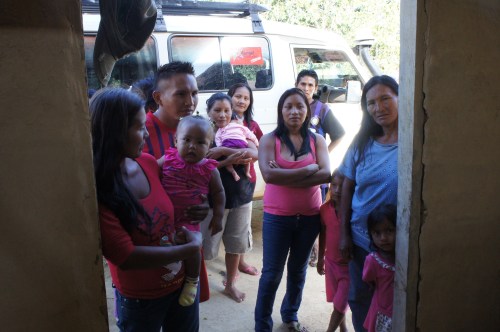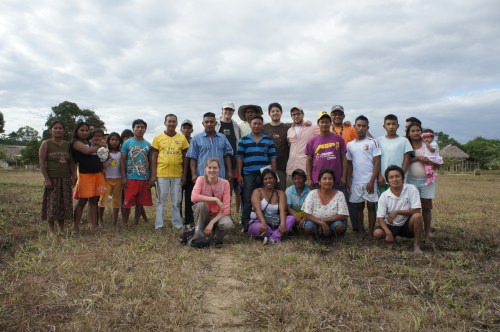Guaniamo, A Piaroan Experience.
Everyone sprung to action, looking for a tree limb or log big enough to leverage the 4×4 up. Patrick, our host, and Jose Lugo, a farmer from the Ocumare region, moved quickly — donning rubber boots and looking in the river for a log big enough. They found one and hoisted it up. After trying a few leverage points and only falling in the river once, they managed to pry the truck up just enough so the driver could throw it into reverse and skid backwards up the river bank. The second attempt was much more successful and we were soon all back in the 4×4 and bumping along, the sides of our vehicle brushing vegetation on both sides. Suddenly, something loomed in our headlights. It was a man! With a rifle! In the middle of the night. With no light. In the jungle. Was this the part where we were getting kidnapped? But then I heard someone in the back seat whisper, “cazador” (hunter in Spanish) and I breathed a sigh of relief. But as we passed him, he waved and I thought, “you my friend have got cojones.”
We arrived at the village around 11:30 at night and set up our hammocks in a thatched mud building while some bleary eyed Piaroans looked on curiously at all the hubbub of guests. The next day dawned early and I got to breakfast on a guanabana. Little did I know, this would be the last food I would be getting for awhile. Due to some mix ups or things lost in translation, the plan to cook up the supplies and eat together with the villagers was not happening. Thank goodness for protein bars!
The whole village gathered and we trekked into the forest to see the cacao trees. Jose Lugo and Patrick led a workshop on pruning. Like many fruit trees, cacao trees do better when the branches that grow downward or don’t produce much fruit are trimmed off. It also allows more air to circulate, which keeps pests down.
The farmers seemed very receptive and tried their hand at pruning some limbs. If they can implement what they learned in the workshop, it will increase their yields and health of the pods.
We trekked back to the village, our bellies grumbling thinking we were heading back to lunch, but we were sadly mistaken. It was time for the presentation part of the workshop.
After lunch, we learned that there were not one, but two communities from the same indigenous group who grew cacao. They used to be all one community and had split due to religious differences several years ago. We came to understand that they were expecting us to visit as well and that they were “just down the road.” I broke the number one rule of traveling: sensible shoes and slipped on some sandals since we were going “just down the road.”
Over an hour later, we were told to get out of the 4×4 and get into a wooden dugout canoe that really didn’t seem to have a back. At the moment we arrived it was piloted by two eight-year-olds, who were soon rescued by their dad who was waiting on our side of the river. We made it across without anyone getting too soaked and then got on the back of a motorbike with a Piaroan teenager to be driven down a bumpy dirt single-track lined path with rather abundant and sharp bushes/low hanging branches. I was about a head taller than my Piaroan driver and he didn’t really take this into account in his driving route, but thankfully, I made it through unscathed.
The second community was overjoyed that we were there and we quickly fell in love with them as they brought forth woven baskets filled with bananas, pineapple, and sugar cane. It was the best banana I have ever eaten.
We were shown to the school building where Patrick and Lugo would lead the fermentation and drying workshop. It was fenced in, like many schools, but there, the school is fenced to be able to lock the children in rather than keep strangers out. Apparently, many of the children would rather run and play in the forest than attend classes (and who can really blame them, they live in tropical paradise!). The workshop went smoothly and again the whole village turned out. Their fermentation rates were much better than the previous village, but they were very interested in how to improve more. We also got to talk to them about how we make chocolate and how we want to make the best chocolate possible from the best beans possible, which is why they, as farmers, are so important.
After the lecture some of us took a swim. I was busy taking photos and when I gestured to the elderly Piaroan man to ask if he was going swimming where the others were, he looked at me horrified. I shrugged it off, but didn’t rush to join my comrades in the beautiful stream. We later learned this “swimming hole” was where the whole town did their dishes.
The sun was getting low, but there was one last surprise. DINNER. Rice, guinea fowl, mortadella, and fried plantains were served up and I was beside myself, I was so happy.
Then, it was back to the first village for one more abbreviated night in the hammocks as we left before dawn to head back to Caracas.
Driving back out over the crazy trail-road made me appreciate these villages’ cacao that much more because they export 40 metric tons per year and to transport it, they take it out one metric ton at a time. That’s 40 trips of about twelve hours each. And all those trips have to happen in the season when it is not flooding, which is only about four months out of the year. It’s pretty amazing that these beans make it to market at all. Juana, a farmer in Sucre who was with us on the trip, told us the first time they tried to sell their beans, she told them to come meet her so they could talk about it and they showed up at her house in Sucre (which is the complete opposite end of the country) with their whole harvest of 40 metric tons.
Thanks to Patrick, he was able to help Juana find a market for these beans, which brought them to us and ultimately, to you. And I appreciate them so much more knowing just how far they came and the wonderful farmers they came from.
Also, a big thank you to Diego, who is a professional photographer, for letting us use his photos!












Loved this. Thanks for posting it.
Hello,
I was wondering if you offer any organic chocolate?